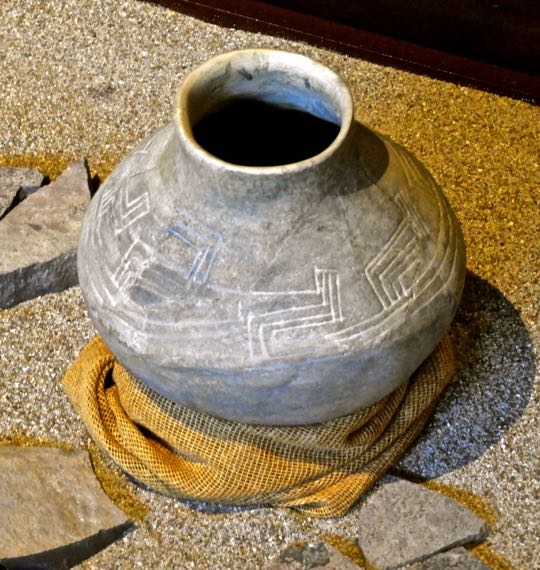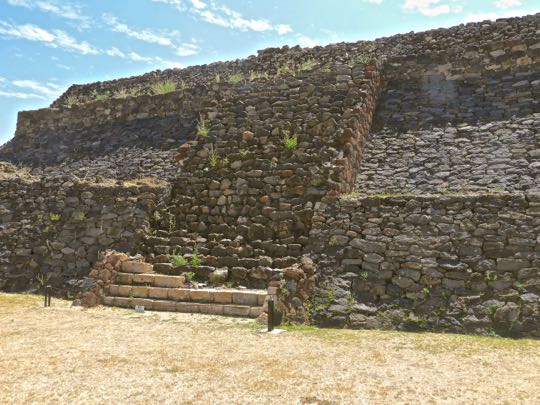In this third and final part of my Peralta series, we'll take a look at artifacts from the site's museum that illuminate various aspects of the life of Peralta's ancient inhabitants. These will include objects of daily life, trade practices, burial practices, and how the city came to be abandoned. To locate Peralta, see Part 1.
Overview
The author, perusing a display at Museo de Peralta. The museum is located near the site's parking lot. It is here that you pay the modest $39 peso ($1.86 USD) fee prior to visiting the ruins. The display above explains some of the history and culture of El Bajio (The Lowland).El Bajio is the region between Querétaro and Jalisco from east to west, and from the mountains of Guanajuato in the north to those of Michoacan in the south. During the Classic and Epi-Classic periods (100-900 AD), the region was thickly settled. It contained a number of substantial cities, including Peralta with its 10,000 inhabitants.
Ceramic items like this were used to prepare and serve food. The plate demonstrates the high level of artistry of pre-hispanic potters. Cultivated plants provided food staples such as maiz (corn), beans, squash, chiles and amaranth. Together, these provided a remarkably balanced and healthy diet.
Artifacts of daily life
Maiz was so important to pre-hispanic societies that it appears prominently in many creation myths. From it, the ancient people made tortillas, tamales, gruel, and a drink called atole. Only a handful of animals were domesticated for food, including turkeys and dogs. People supplemented their diets with wild plants, as well as game animals such as deer, rabbits, birds, and insects.
A bowl with an unusual base caught my eye. I have not seen a bowl set on a base like this at any other ancient site I have visited. Most of the pottery and other artifacts in the displays were recovered from tombs or burial sites. Ceramics like this left on the surface stood little chance of surviving over the millennia. This makes the discovery of intact tombs an especially important source of information about ancient cultures.
Grave robbing is the bane of archeology. Often, robbers will smash pottery to see if valuables are stored inside. Even when stolen items are intact, they will have lost the context in which they were recovered. Cultural information can be inferred from the positions of objects in relation to one another. The level soil in which they were discovered can reveal time frames. Looting destroys all this.
In addition to religious rituals, whistles were used by hunters to mimic animal noises and by warriors to terrify enemies with shrieking sounds. Curanderos (healers) used them to induce a dream-state in order to treat certain illnesses. They were also employed in death rituals related to human sacrifice. Although modern scientists are able to produce sounds using these ancient instruments, they don't really know what the music played on them sounded like.
Trade and trade routes
Mesoamerican trade routes stretched from New Mexico to Honduras and reached both the Pacific Coast and the Caribbean. One region where many of them crossed was El Bajio. The merchants who organized the caravans had their own god, whose painted image decorates the walls of the Epi-Classic city of Cacaxtla (near Puebla), a contemporary of Peralta. While it was well-nourished by its fields of maiz, beans, and squash, trade made Peralta rich.
The obsidian trade was as important to pre-hispanic societies as the oil trade is for modern countries. A significant source of the volcanic glass has been found near present-day Penjamo, only about 33km (20mi) from Peralta. Scientific analysis of an obsidian tool found in Texas showed that the volcanic glass from which it was crafted may have come from Penjamo, demonstrating the extent of the pre-hispanic trade networks.
Painted bowls were traded widely in Mesoamerica. Although ceramics are both weighty and fragile, they were also a major trade item. In fact, archeologists have long used pottery and potsherds as markers to understand trade between different city-states. Whole systems have been developed for naming different cultural phases according to pottery styles and for tracing the influence of one culture on another.
Bowls like the one above would have been considered luxury goods. With careful packing and handling, they would have been worth risking on a long trek. Elites shopping in the markets in distant city-states practiced conspicuous consumption, just as modern people do. Assuming the breakage was not significant, traveling merchants could make a healthy profit on their pottery.
Burial rituals
In some Mesoamerican societies, artificial cranial deformation was practiced. Elite families would bind the skulls of their infant children with wood and leather. This was done to elongate the skull so that, as an adult, the person would appear different from commoners. However, the adult skull in this burial shows no sign of elongation. This suggests that the practice was not followed by Peralta's elites.
Urns were sometimes used for what archeologists call "secondary burials". Sometime after the original burial, bones would be collected and reburied elsewhere, often within a pot like this. The purposes and meanings of pre-hispanic secondary burials are not well understood and may have varied from society to society, as well as over time.
I have seen scores of masks like this at sites all over Mexico. Their close similarity suggested to me that they were not the creations of individual craftsmen but mass produced. In fact, recent scientific investigation shows that Teotihuacan manufactured them on a large scale, but at a site far from the capital city. Production occurred in the state of Puebla, possibly at the ancient city of Cholula.
The end of Peralta: drought, invasion, or both?
Chicomoztoc ("Place of the Seven Caves") appears in the origin myths of several Chichimeca tribes. The drawing above is from a 1550 AD depiction by one tribesman. In the myths, Chicomoztoc is usually described as a mountain containing a multi-chambered cave. It was the origin point, or at least a stop-over, on a great migration. In the tribesman's drawing, each of the chambers contains a different tribe. In some versions, the tribes departed separately over time.
The Mexica (Aztec) version is the most famous. Even after they had won an empire, they still glorified their Chichimeca origins in the last great pre-hispanic wave of migrants. However, the myth may date back at least 600 years prior to the Mexica. In fact, each of the three great pyramids of Teotihuacán represents a mountain and each has a man-made cave beneath it. Some even have multiple chambers. The location of Chicomoztoc, if it actually exists, remains a mystery.
On the hillsides, some of the Chichimeca warriors aim obsidian-tipped arrows at the defenders. Others wave weapons called macuahuitls. These flat, wooden swords had edges filled by razor-sharp obsidian blades. In their other hands, the warriors hold up circular shields. This painting was created by an indigenous artist after the Spanish arrival, but is probably an accurate portrayal of pre-hispanic warfare at the time of the Chichimeca invasion of El Bajio.
Human skull, shortly after it was unearthed. What happened to Peralta's inhabitants? Were they massacred and their city razed? There is clear evidence of such destruction at about the same time at other Epi-Classic cities such as La Quemada ("The Burned Place"). The Spanish gave its ruins that name because the great conflagration that destroyed the city was still evident after 600 years.
The defensive hilltop position and strong walls of the Recinto de los Gobernantes showed that its builders anticipated such attacks and may have experienced some. To date, archeologists have not unearthed evidence of destruction at Peralta similar to what had happened at La Quemada. However, news of the fates of La Quemada and other Epi-Classic cities such as Xochicalco, Cantona, and Cacaxtla would have spread rapidly across Mesoamerica.
Such frightening news, combined with economic collapse caused by drought and the disruption of the Epi-Classic trade networks, may have resulted in a panicked flight to safer locales. One of those places could have been the rising Toltec state at Tula, in today's Hidalgo state. Lacking written records, we just don't know. What we do know is that El Bajio was depopulated within a few decades. Except for scattered bands of nomads, it remained empty for the next 600 years.
This ends Part 3 of my Peralta series and completes the series itself. I hope you enjoyed it. If so, please leave any thoughts or questions in the Comments section below. If you do leave a question, please be sure to include your email address so that I may respond in a timely manner.
Hasta luego, Jim




































